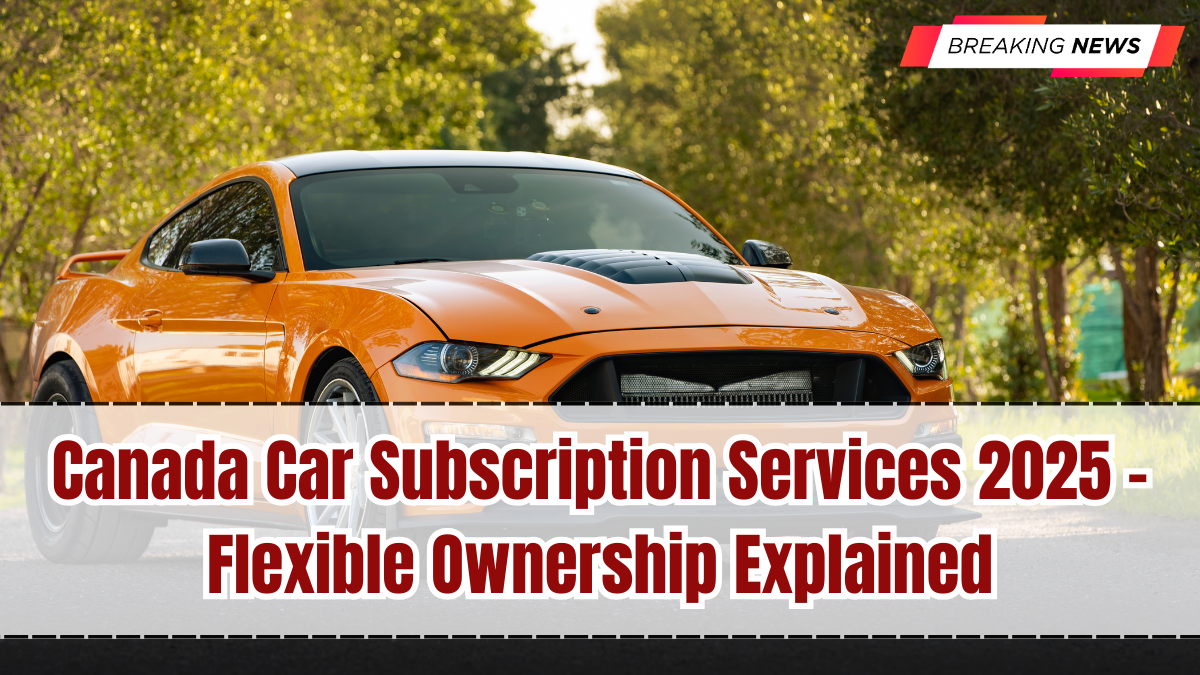The Canada Car Subscription Services 2025 trend is changing the way Canadians think about car ownership. Instead of committing to a purchase or a long-term lease, drivers are choosing subscription programs that offer flexibility, convenience, and all-in-one costs.
This model, already popular in Europe and the United States, is gaining momentum across Canadian cities. From young professionals to families, more people see subscriptions as a modern alternative that adapts to their needs.
But how exactly do car subscriptions work, how much do they cost, and are they really better than leasing or buying in 2025?

What Are Car Subscription Services?
Car subscription services allow drivers to use a vehicle for a monthly fee without owning it. The fee usually covers insurance, maintenance, roadside assistance, and even registration. Drivers simply pay, pick a car, and start driving.
Unlike traditional leasing, subscriptions are short-term and highly flexible. Some plans last just a few weeks, while others let users swap vehicles as their needs change. It’s a “Netflix-style” approach to cars, designed for modern lifestyles.
Why Are Canadians Turning to Subscriptions in 2025?
Several reasons explain the surge in interest.
First, car ownership is becoming more expensive. High insurance rates, maintenance costs, and loan interest make subscriptions attractive because they bundle everything into one predictable payment. Second, younger generations value flexibility more than ownership. Many prefer switching cars regularly rather than being tied to one vehicle for years.
Finally, subscriptions suit people who live in urban areas and don’t drive daily. They can access vehicles only when needed, avoiding the burden of long-term costs.
How Much Do Car Subscription Services Cost in 2025?
Costs vary depending on the provider and vehicle type.
Basic subscriptions for compact cars start at around $500–$600 per month. Mid-range SUVs average between $800 and $1,200 monthly. Luxury or electric vehicles can cost $1,500 or more, but these include insurance, servicing, and registration fees.
While this may seem expensive compared to owning, it eliminates unexpected expenses like repairs, which can quickly add up. For city dwellers or those who only need cars part-time, subscriptions can be cost-effective.
Who Are the Top Car Subscription Providers in Canada?
Several companies are leading the market in 2025.
-
FlexDrive Canada: Offers a wide range of cars, from compact sedans to SUVs, with flexible swap options.
-
Clutch Drive: Focuses on short-term subscriptions with home delivery in major cities.
-
AutoOne Drive: Popular in Toronto and Vancouver, providing premium cars under subscription plans.
-
Luxury automaker programs: BMW, Volvo, and Audi offer in-house subscription services for their vehicles.
These companies are expanding quickly, targeting urban professionals and businesses with fleet needs.
How Do Subscriptions Compare to Leasing?
Leasing and subscriptions share similarities but differ in flexibility.
Leasing typically requires a multi-year commitment, mileage restrictions, and separate insurance. Subscriptions, by contrast, are short-term and more flexible, with insurance and maintenance included. Subscriptions are ideal for people who want hassle-free driving without long-term ties.
Leasing may still be cheaper over several years, but subscriptions win on convenience and adaptability.
Are Electric and Hybrid Cars Available in Subscriptions?
Yes, EVs and hybrids are increasingly part of subscription programs.
Many providers now include electric SUVs and sedans in their fleets. For example, Tesla, Hyundai, and Kia models are available on subscription in major cities. This allows drivers to experience EVs without committing to long-term ownership or worrying about battery warranties.
With charging networks expanding in 2025, EV subscriptions are becoming one of the fastest-growing segments.
What Are the Pros and Cons of Car Subscriptions?
Subscriptions offer clear advantages but also some trade-offs.
Pros:
-
One monthly payment covers everything.
-
Short-term flexibility with easy swaps.
-
No long-term financial commitments.
Cons:
-
Higher monthly costs than traditional ownership.
-
Limited availability in rural areas.
-
Vehicle choices can be narrower compared to buying.
For people who value convenience and flexibility, pros outweigh the cons. For daily drivers with high mileage needs, ownership may still be cheaper.
How Are Businesses Using Subscriptions?
Businesses are increasingly adopting subscriptions for their fleets.
Startups and small companies prefer subscriptions over leasing because they can scale fleets up or down based on demand. Delivery services, ride-hailing companies, and corporate teams use subscription vehicles to avoid upfront costs.
This business adoption is also pushing providers to expand services beyond just individuals.
Conclusion
The Canada Car Subscription Services 2025 trend reflects a shift in consumer behavior. Canadians want flexibility, convenience, and predictable costs, making subscriptions an attractive alternative to leasing and ownership.
While not the cheapest option, subscriptions appeal to urban professionals, eco-conscious drivers, and businesses needing adaptable fleets. With EVs and hybrids now included, subscriptions are set to grow even further in the coming years.
For drivers who value simplicity and adaptability over long-term commitments, subscriptions might be the future of mobility in Canada.
FAQs
What is a car subscription service?
It’s a program where drivers pay a monthly fee covering insurance, maintenance, and registration to use a car.
How much do subscriptions cost in Canada in 2025?
Between $500 and $1,200 monthly for most cars, with luxury models costing more.
Are EVs part of subscription programs?
Yes, many providers now offer electric and hybrid cars as part of their fleets.
How does it differ from leasing?
Subscriptions are short-term and more flexible, while leasing requires multi-year commitments and separate insurance.
Who benefits most from subscriptions?
Urban drivers, professionals, and businesses that want flexible access without ownership costs.
Click here to know more.
